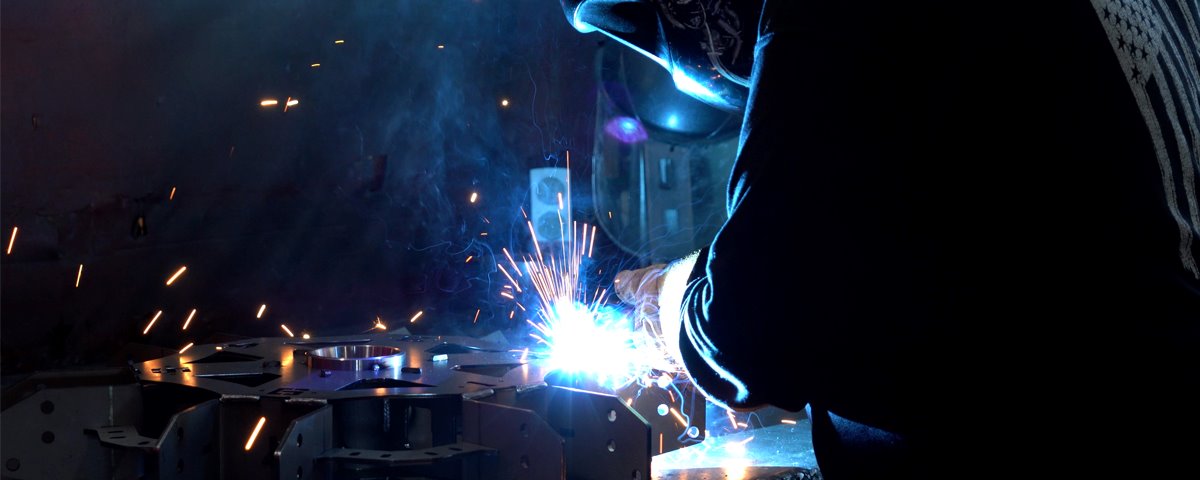All Riley Hopkins presses and equipment are manufactured by a team of experienced engineers in the USA. This is great for customers, because it keeps quality standards high, offers fast shipping, and provides printers with great customer service.
Ever wondered how a Riley Hopkins press gets made? Chris Drury, Director of Manufacturing and Distribution, gives a behind-the-scenes tour of the making of a Riley Hopkins 300 6x4.
STEP 1: CNC LASER CUTTER
Everything in the machine shop starts with flat steel. The piece of steel is taken to the CNC (Computer Numerical Controlled) laser cutter, where the parts of the press are created. The CNC laser cutter can make these crucial parts the same way every time. Today, the machine is cutting hinge pockets for the Riley 300. The cut quality is nearly perfect, and all the parts are uniform.
RELATED: WHY RILEY HOPKINS SCREEN PRINTING PRESSES ARE LOCALLY MANUFACTURED
STEP 2: PRESS BREAK
From the laser cutter, the steel pieces either head to the welding department or to the press brake. A press brake is a CNC machine that can form steel, aluminum, and stainless steel like it’s a piece of paper.
To get started, the operator James bends a part and calibrates the angles using a protractor. All the bends need to be 90°. Getting the correct specifications can take a couple of adjustments.
Once it’s all up to par, James can kick it into high gear and knock out piece after piece with the same precision.
STEP 3: WELDING
Once the hinge pocket has been bent into shape, it heads to the welding center, where a team of expert welders brings it all together. Welder David is creating a 6x4 color wheel using the hinge clamps we’ve been following.
ROBOTIC WELDING
Robotic welders can run at about three times the speed human welders can. Don’t worry, this robot is friendly. This robot even has a name: Roberto. No hostile takeovers here!
Esmerelda sets up Roberto to create a part, then heads to her welding cell to do some welding of her own. The welding center runs like a fully-oiled machine with the help of a robotic welder and a few human welding machines.
STEP 4: CNC MACHINING
This piece of technology is new to the Riley Hopkins manufacturing line in 2022. It uses Computer Numerical Controls (CNC) to create the same parts over and over. This machine works much like the laser cutter. It makes precision cuts and uses liquid coolant to keep the cutting tools lasting longer. This process also cleans out metal chips from the cutting area.
Anything that requires vertical machining comes through this machine. Typically these are parts made from billet aluminum, like the registration gate on the 300.
RELATED: HOW RILEY HOPKINS SCREEN PRINTING EQUIPMENT EVOLVES TO BENEFIT PRINTERS
STEP 5: ASSEMBLY
Now that all the parts are created, it’s time for assembly. The assembly space is small for maximum efficiency. Maria is assembling the Riley Hopkins 300 we’ve been following and installs each print head by hand.
Each Riley Hopkins press is built one at a time for quality control. Every little detail has been calibrated for customers. When printers unbox a press, it will be easy to assemble and ready to rumble.
STEP 6: PACKING & SHIPPING
Once a press is assembled and has passed quality assurance checks, it’s boxed up in wood crates and ready for shipping. Though Riley Hopkins presses are built one at a time, they’re kept in stock for quick shipping, so printers can put the pedal to the metal.

Going behind the scenes is a great way to see how Riley Hopkins presses are built. Every press is built by hand to ensure the printer gets the best equipment possible and can hit the ground running.

